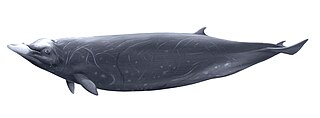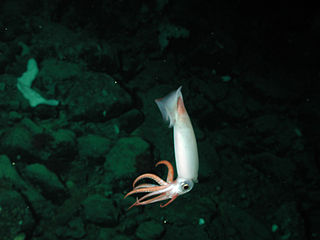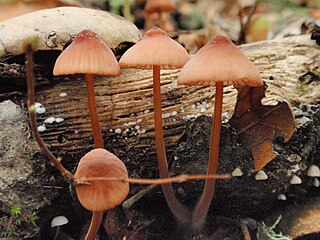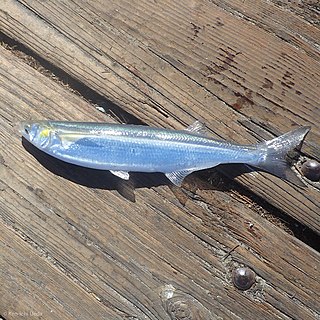
Hubbs' beaked whale was initially thought to be an Andrews' beaked whale when discovered by ichthyologist Carl Hubbs; however, it was named in his honor when it was discovered to be a new species. This species has the typical dentition found in the genus, but its main outstanding features are a white "cap" on the head and very extensive scarring. The species is known from 31 strandings, a few at-sea sightings, and observations of two stranded whales that were kept in captivity for 16–25 days.

The Gonatidae, also known as armhook squid, are a family of moderately sized squid. The family contains about 19 species in three genera, widely distributed and plentiful in cold boreal waters of the Pacific Ocean. At least one species is known from Antarctic waters, and two from the North Atlantic. The genus Eogonatus was created for the species known as Eogonatus tinro because it did not have hooks on the tentacular club and it has 5 rows of teeth on the radula. Molecular studies in allozymes and mitochondrial DNA have indicated that this species nests within the genus Gonatus, although other authorities treat it as a synonym of Gonatopsis okutanii.

The Humboldt squid, also known as jumbo squid or jumbo flying squid (EN), and Pota in Peru or Jibia in Chile (ES), is a large, predatory squid living in the eastern Pacific Ocean. It is the only known species of the genus Dosidicus of the subfamily Ommastrephinae, family Ommastrephidae.

Gonatus fabricii, the Boreo-atlantic Armhook Squid, is a squid in the family Gonatidae. It occurs in the northern Atlantic Ocean from Canada to the Barents Sea.

Gonatus onyx is in the class Cephalopoda and in the phylum Mollusca. It is also known as the clawed arm hook squid or the black-eyed squid. It got these names from the characteristic black eye and from its two arms with clawed hooks on the end that extend a bit further than the other arms. It is a squid in the family Gonatidae, found most commonly in the northern Pacific Ocean from Japan to California. They are one of the most abundant cephalopods off the coast of California, mostly found at deeper depths, rising during the day most likely to feed.

Berryteuthis anonychus, also known as the minimal armhook squid or smallfin gonate squid, is a species of squid in the family Gonatidae. It is distinguished from other gonatids by the lack of hooks on all members, except for females on the base of arms I to III.

Gonatus is a genus of squid in the family Gonatidae, comprising twelve species, and therefore containing the most species in the family. Adult squid belonging to species in this genus are notable for their lack of tentacles.

Felimare californiensis, common name the California blue dorid, is a species of colourful sea slug or dorid nudibranch, a marine gastropod mollusk in the family Chromodorididae that eats dysideid sponges.

Mycena californiensis is a species of fungus in the family Mycenaceae. It is a common and abundant species in the coastal oak woodlands of California, where it grows saprobically, feeding on the fallen leaves and acorns of various oak species. First described in 1860 by Berkeley and Curtis, the species was collected four years earlier during an exploring and surveying expedition. It was subsequently considered a doubtful species by later Mycena researchers, until a 1999 publication validated the taxon. Mycena elegantula is considered a synonym.

Neotrypaea californiensis, the Bay ghost shrimp, is a species of ghost shrimp that lives on the Pacific coast of North America. It is a pale animal which grows to a length of 11.5 cm (4.5 in). One claw is bigger than the other, especially in males, and the enlarged claw is thought to have a function in mating. N. californiensis is a deposit feeder that lives in extensive burrow systems, and is responsible for high rates of bioturbation. It adversely affects oyster farms, and its numbers are controlled in some places by the application of pesticides. It carries out an important role in the ecosystem, and is used by fishermen as bait.

The blind goby is a species of fish in the goby family Oxudercidae, the only species in the genus Typhlogobius. It is native to the coastlines of southern California in the United States and Baja California in Mexico, where it commonly inhabits the burrows of shrimp of the genus Callianassa. The adult of the species is completely blind and lacks pigmentation, while the juvenile has rudimentary eyes that help it find the shrimp burrows. This species can reach a length of 8.3 centimetres (3.3 in) TL.

Atherinopsis californiensis, the jack silverside or jacksmelt, is a species of neotropical silverside native to the Pacific coast of North America from Oregon, United States to southern Baja California, Mexico. This species grows to 45 cm (18 in) in total length and is important commercially as a source of human food. It is the only known member of its genus. The adults occur in inshore areas, such as bays. They form schools. This species is a demersal spawners in inshore habitats, it is oviparous and the larvae are planktonic, living at the very surface of the water and feeding on phytoplankton. The eggs are attached to one another and to the substrate by adhesive filaments in the chorion.

Paralithodes californiensis, also known as the spiny king crab and the California king crab, is a species of king crab It is closely related to P. rathbuni with the same common names being used for the two and some authorities suggest that they might be conspecific. P. californiensis is found on muddy or rocky bottoms at depths of 145–300 m (476–984 ft) in the Pacific Ocean off southern California.

Gonatus antarcticus is a squid in the family Gonatidae. The species is known with certainty only from southern Atlantic waters but it may have a circum-Antarctic distribution.

Oxyjulis californica is a species of wrasse native to the eastern Pacific Ocean along the coasts of California and Baja California. Its distribution extends from Salt Point in Sonoma County, California, to southern central Baja California, near Cedros Island. It is a very common species; its common name in Spanish is señorita.
Gonatopsis okutanii is a species of squid from the family Gonatidae from the northern Pacific Ocean. It is of uncertain taxonomic status, the presence of remnant tentacles on spent females indicate that this species does not belong in the genus Gonatopsis and the differences between this species and Gonatus makodai have led to some authorities stating that G. okutanii is a junior synonym of Eogonatus tinro. However the World Register of Marine Species still recognises Gonatopsis okutanii as the valid name for this taxon.
Tindallia californiensis is a Gram-positive, extremely haloalkaliphilic, strictly anaerobic, acetogenic and motile bacterium from the genus of Tindallia which has been isolated from sediments from the Mono Lake in California.
Gonatus pyros, the fiery gonate squid, or fiery armhook squid, is a species of squid within the family Gonatidae. The distribution of the species is in the central and eastern North Pacific from the Aleutian Islands to Baja California, where it lives at depths of 563–667 m (1,847–2,188 ft) in oceanic environments. Their planktonic paralarvae are usually found at depths of 200–300 m (660–980 ft). High abundances occur over continental slopes in the summer. It grows to lengths of 125 mm (4.9 in).














